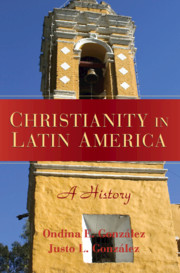Book contents
- Frontmatter
- Contents
- Preface
- Introduction
- 1 Foundations
- 2 The Arrival of Christianity
- 3 The Shaping of the Faith
- 4 Reform Movements
- 5 The Church in Turmoil
- 6 The Church's New Place
- 7 Protestant Immigration
- 8 An Expanding Protestant Presence
- 9 Catholicism after Vatican II
- 10 Pentecostalism and Autochthonous Movements
- 11 By Way of Conclusion
- Some Suggestions for Further Reading
- Sources Referenced
- Index
5 - The Church in Turmoil
Published online by Cambridge University Press: 05 June 2012
- Frontmatter
- Contents
- Preface
- Introduction
- 1 Foundations
- 2 The Arrival of Christianity
- 3 The Shaping of the Faith
- 4 Reform Movements
- 5 The Church in Turmoil
- 6 The Church's New Place
- 7 Protestant Immigration
- 8 An Expanding Protestant Presence
- 9 Catholicism after Vatican II
- 10 Pentecostalism and Autochthonous Movements
- 11 By Way of Conclusion
- Some Suggestions for Further Reading
- Sources Referenced
- Index
Summary
As we recall from Chapter 4, the eighteenth century opened with the church firmly established in Latin America, its place unassailable, its importance undeniable. It was, after all, a partner with the state in the conquest and colonization of the Indies. And it was the voice of God on the earth. At least, that is what the church thought. As the century progressed, it would be proved wrong again and again.
The ascension of the House of Bourbon to the throne of Spain in 1700 changed much for the Americas. Even from the beginning of the century there was clear antagonism between the church and the new ruling house of Spain, as French ideas of monarchical rights held sway. Slowly and surely over the course of the century, the state began exerting authority over the church until the reign of Charles III (1759–1788), when the Bourbon Reforms accelerated the rate of change. Charles altered the relationship between the church and state by making the former the servant of the latter. He used whatever powers were at his disposal – as an absolutist monarch with the patronato real those powers were rather substantial – to mold the church into his instrument. And in many ways he succeeded.
As we move on, we also recall that in Portugal and its colonies, it was the rise to power of the Marquis of Pombal in mid-century that resulted in that crown's tightening its authority over the church.
- Type
- Chapter
- Information
- Christianity in Latin AmericaA History, pp. 131 - 159Publisher: Cambridge University PressPrint publication year: 2007



